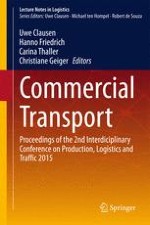2016 | Buch
Commercial Transport
Proceedings of the 2nd Interdiciplinary Conference on Production Logistics and Traffic 2015
herausgegeben von: Uwe Clausen, Hanno Friedrich, Carina Thaller, Christiane Geiger
Verlag: Springer International Publishing
Buchreihe : Lecture Notes in Logistics
